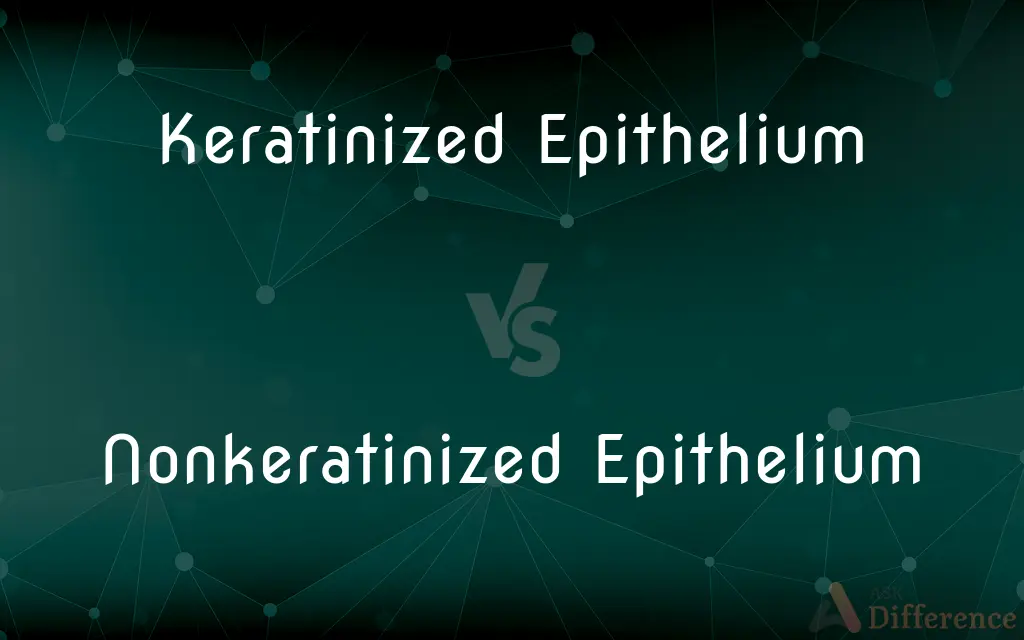Keratinized Epithelium vs. Nonkeratinized Epithelium — What's the Difference?
By Tayyaba Rehman & Maham Liaqat — Published on February 23, 2024
Keratinized epithelium contains keratin, a protective protein, making it tough and water-resistant, found in skin areas exposed to friction. Nonkeratinized epithelium lacks surface keratin, remaining moist to protect internal linings of organs.

Difference Between Keratinized Epithelium and Nonkeratinized Epithelium
Table of Contents
ADVERTISEMENT
Key Differences
Keratinized and nonkeratinized epithelia are specialized tissue types that serve different functions based on their location and structure in the body. Keratinized epithelium, characterized by the presence of keratin, forms the outer layer of the skin, providing a durable and water-resistant barrier against environmental damage, pathogens, and water loss. This type of epithelium is adapted to areas subject to abrasion and dry conditions, such as the epidermis of the skin, hair, and nails, where protection and minimal moisture loss are critical.
Nonkeratinized epithelium, on the other hand, lacks a surface layer of keratin, allowing it to remain moist and soft, which is essential for its protective role in wet or lubricated environments.
The key difference in their structure reflects their distinct functions: keratinized epithelium is built for protection and durability, with layers of dead cells filled with keratin on the surface, while nonkeratinized epithelium is structured to maintain a moist surface environment for absorption, secretion, or smooth passage of substances.
In terms of cell composition, keratinized epithelium undergoes a process of keratinization where cells migrate upwards, lose their nuclei, and become filled with keratin before dying, forming a tough, resistant layer. Nonkeratinized epithelial cells retain their nuclei and remain alive up to the surface, ensuring the tissue remains flexible and moist.
Understanding these differences is crucial for comprehending how the body protects itself and maintains different internal environments, highlighting the adaptability and specialized nature of epithelial tissues.
ADVERTISEMENT
Comparison Chart
Surface Layer
Contains keratin, dead cells
Lacks keratin, cells remain alive
Function
Protection against abrasion, pathogens, water loss
Protection in moist environments, facilitates passage
Moisture
Dry and water-resistant
Moist and soft
Cell Characteristics
Cells lose nuclei and fill with keratin as they die
Cells retain nuclei and stay alive to the surface
Compare with Definitions
Keratinized Epithelium
Protects against environmental damage.
The epidermis shields the body with its keratinized epithelial layer.
Nonkeratinized Epithelium
Facilitates absorption and secretion.
The mouth's nonkeratinized epithelium also aids in taste and saliva production.
Keratinized Epithelium
Found in areas exposed to harsh conditions.
Fingernails are composed of keratinized epithelium for protection.
Nonkeratinized Epithelium
Protects internal linings of organs.
The esophagus is lined with nonkeratinized epithelium to protect against food passage.
Keratinized Epithelium
Contains dead cells filled with keratin.
Calluses on feet develop from keratinized epithelium due to pressure.
Nonkeratinized Epithelium
Lacks a keratin surface layer, staying moist.
The mouth's lining is nonkeratinized epithelium to facilitate chewing and swallowing.
Keratinized Epithelium
A protective, water-resistant tissue layer.
The skin's outer layer is made of keratinized epithelium to prevent water loss.
Keratinized Epithelium
Undergoes keratinization for durability.
Hair's strength comes from keratinized epithelium.
Common Curiosities
How do nonkeratinized epithelial tissues remain moist?
They lack a keratin layer and are located in areas with moisture or secretions that keep the surface wet.
Why is keratin important in epithelial tissue?
Keratin provides a protective barrier against environmental damage, pathogens, and prevents water loss, enhancing durability.
Is keratinized or nonkeratinized epithelium better for protection?
Keratinized epithelium provides better protection against physical and environmental challenges, while nonkeratinized epithelium protects internal organs where moisture is necessary.
What is keratinized epithelium?
Keratinized epithelium is a type of tissue that contains keratin, a protective protein, making it tough and water-resistant, primarily found on the skin's surface.
Why is understanding these types of epithelium important in medicine?
It aids in diagnosing diseases, understanding tissue damage and healing, and in the design of medical treatments and interventions.
Can nonkeratinized epithelium provide any protection against pathogens?
Yes, despite being less tough than keratinized epithelium, its moist environment and secretions, such as saliva or mucus, can contain antimicrobial properties that help protect against pathogens.
What is the significance of keratinized epithelium in wound healing?
Keratinized epithelium plays a crucial role in wound healing by forming a protective barrier over wounds, which helps prevent infection and water loss during the healing process.
How does the cell structure differ between keratinized and nonkeratinized epithelium?
In keratinized epithelium, cells lose their nuclei and fill with keratin as they die, while in nonkeratinized epithelium, cells retain their nuclei and remain alive up to the surface.
Can keratinized epithelium be found inside the body?
Typically, it's found on external surfaces exposed to the environment, such as skin, hair, and nails, rather than internal surfaces.
Can the type of epithelial tissue change?
Yes, under certain conditions, such as chronic irritation, nonkeratinized epithelium can undergo keratinization, a process known as metaplasia.
What role does nonkeratinized epithelium play in the body?
It provides protection for internal organs in moist environments, facilitating smooth passage and flexibility.
How do health conditions affect nonkeratinized epithelial tissues?
Conditions like nutritional deficiencies, dehydration, or diseases such as Sjögren's syndrome can affect the moisture and integrity of nonkeratinized epithelia, leading to discomfort and increased risk of infection.
How does aging affect keratinized and nonkeratinized epithelia?
Aging can lead to thinning and reduced elasticity in both types of epithelia, potentially compromising their protective functions and altering moisture levels, especially in nonkeratinized tissues.
How does keratinized epithelium respond to constant friction?
It may thicken and form a callus, increasing the layer of dead, keratinized cells to provide extra protection against mechanical stress.
How do environmental factors like UV exposure affect keratinized epithelium?
UV exposure can damage keratinized epithelium, leading to sunburn and increasing the risk of skin cancer. It underscores the need for protective measures, such as sunscreen.
Share Your Discovery

Previous Comparison
ACT vs. SAT
Next Comparison
Isobutyl vs. Sec-butylAuthor Spotlight
Written by
Tayyaba RehmanTayyaba Rehman is a distinguished writer, currently serving as a primary contributor to askdifference.com. As a researcher in semantics and etymology, Tayyaba's passion for the complexity of languages and their distinctions has found a perfect home on the platform. Tayyaba delves into the intricacies of language, distinguishing between commonly confused words and phrases, thereby providing clarity for readers worldwide.
Co-written by
Maham Liaqat













































